Phylogenetic interrelationships of ginglymodian fishes (Actinopterygii: Neopterygii)
- PMID: 22808031
- PMCID: PMC3394768
- DOI: 10.1371/journal.pone.0039370
Phylogenetic interrelationships of ginglymodian fishes (Actinopterygii: Neopterygii)
Abstract
The Ginglymodi is one of the most common, though poorly understood groups of neopterygians, which includes gars, macrosemiiforms, and "semionotiforms." In particular, the phylogenetic relationships between the widely distributed "semionotiforms," and between them and other ginglymodians have been enigmatic. Here, the phylogenetic relationships between eight of the 11 "semionotiform" genera, five genera of living and fossil gars and three macrosemiid genera, are analysed through cladistic analysis, based on 90 morphological characters and 37 taxa, including 7 out-group taxa. The results of the analysis show that the Ginglymodi includes two main lineages: Lepisosteiformes and †Semionotiformes. The genera †Pliodetes, †Araripelepidotes, †Lepidotes, †Scheenstia, and †Isanichthys are lepisosteiforms, and not semionotiforms, as previously thought, and these taxa extend the stratigraphic range of the lineage leading to gars back up to the Early Jurassic. A monophyletic †Lepidotes is restricted to the Early Jurassic species, whereas the strongly tritoral species previously referred to †Lepidotes are referred to †Scheenstia. Other species previously referred to †Lepidotes represent other genera or new taxa. The macrosemiids are well nested within semionotiforms, together with †Semionotidae, here restricted to †Semionotus, and a new family including †Callipurbeckia n. gen. minor (previously referred to †Lepidotes), †Macrosemimimus, †Tlayuamichin, †Paralepidotus, and †Semiolepis. Due to the numerous taxonomic changes needed according to the phylogenetic analysis, this article also includes formal taxonomic definitions and diagnoses for all generic and higher taxa, which are new or modified. The study of Mesozoic ginglymodians led to confirm Patterson's observation that these fishes show morphological affinities with both halecomorphs and teleosts. Therefore, the compilation of large data sets including the Mesozoic ginglymodians and the re-evaluation of several hypotheses of homology are essential to test the hypotheses of the Halecostomi vs. the Holostei, which is one of the major topics in the evolution of Mesozoic vertebrates and the origin of modern fish faunas.
Conflict of interest statement
Figures
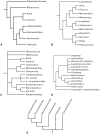


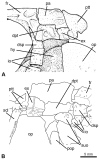



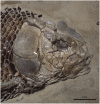







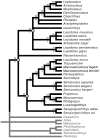







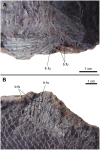
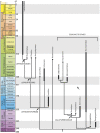

Similar articles
-
Diversity of Mesozoic semionotiform fishes and the origin of gars (Lepisosteidae).Naturwissenschaften. 2010 Dec;97(12):1035-40. doi: 10.1007/s00114-010-0722-7. Epub 2010 Oct 8. Naturwissenschaften. 2010. PMID: 20931168
-
Neopterygian phylogeny: the merger assay.R Soc Open Sci. 2018 Mar 21;5(3):172337. doi: 10.1098/rsos.172337. eCollection 2018 Mar. R Soc Open Sci. 2018. PMID: 29657820 Free PMC article.
-
Phylogenetic analysis of molecular and morphological data highlights uncertainty in the relationships of fossil and living species of Elopomorpha (Actinopterygii: Teleostei).Mol Phylogenet Evol. 2015 Aug;89:205-18. doi: 10.1016/j.ympev.2015.04.004. Epub 2015 Apr 18. Mol Phylogenet Evol. 2015. PMID: 25899306
-
Permian-Triassic Osteichthyes (bony fishes): diversity dynamics and body size evolution.Biol Rev Camb Philos Soc. 2016 Feb;91(1):106-47. doi: 10.1111/brv.12161. Epub 2014 Nov 27. Biol Rev Camb Philos Soc. 2016. PMID: 25431138 Review.
-
'Fish' (Actinopterygii and Elasmobranchii) diversification patterns through deep time.Biol Rev Camb Philos Soc. 2016 Nov;91(4):950-981. doi: 10.1111/brv.12203. Epub 2015 Jun 23. Biol Rev Camb Philos Soc. 2016. PMID: 26105527 Review.
Cited by
-
Ray-finned fishes (Actinopterygii) from the Upper Jurassic (Oxfordian) of the Atacama Desert, Northern Chile.PeerJ. 2022 Aug 2;10:e13739. doi: 10.7717/peerj.13739. eCollection 2022. PeerJ. 2022. PMID: 35935248 Free PMC article.
-
Rise and fall of †Pycnodontiformes: Diversity, competition and extinction of a successful fish clade.Ecol Evol. 2021 Jan 19;11(4):1769-1796. doi: 10.1002/ece3.7168. eCollection 2021 Feb. Ecol Evol. 2021. PMID: 33614003 Free PMC article.
-
A revision of Laeliichthys ancestralis Santos, 1985 (Teleostei: Osteoglossomorpha) from the Lower Cretaceous of Brazil: Phylogenetic relationships and biogeographical implications.PLoS One. 2020 Oct 29;15(10):e0241009. doi: 10.1371/journal.pone.0241009. eCollection 2020. PLoS One. 2020. PMID: 33119676 Free PMC article.
-
Osteology and phylogeny of Robustichthys luopingensis, the largest holostean fish in the Middle Triassic.PeerJ. 2019 Jun 24;7:e7184. doi: 10.7717/peerj.7184. eCollection 2019. PeerJ. 2019. PMID: 31275762 Free PMC article.
-
Fuyuanichthys wangi gen. et sp. nov. from the Middle Triassic (Ladinian) of China highlights the early diversification of ginglymodian fishes.PeerJ. 2018 Dec 20;6:e6054. doi: 10.7717/peerj.6054. eCollection 2018. PeerJ. 2018. PMID: 30595977 Free PMC article.
References
-
- Regan CT. 24. The Skeleton of Lepidosteus, with remarks on the origin and evolution of the lower Neopterygian Fishes. Proc Zool Soc London. 1923;1923:445–461.
-
- Brough J. The Triassic fishes of Besano, Lombardy. London: The Trustees of the British Museum. pp 117+ VII pl. 1939.
-
- Danil’chenko PG. Obruchev DV, editor. Superorder Holostei. 1964. pp. 378–395. editor. Osnovy Paleontologii. Moskva: Akad. Nauk SSSR. (in Russian).
-
- McAllister DE. The evolution of branchiostegals. Bull Natl Mus Canada. 1968;221:1–239.
-
- Gardiner BG. A revision of certain actinopterygian and coelacanth fishes, chiefly from the Lower Lias. Bulletin of the British Museum (Natural History), Geology. 1960;4:239–384.
Publication types
MeSH terms
LinkOut - more resources
Full Text Sources


